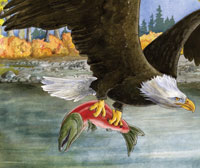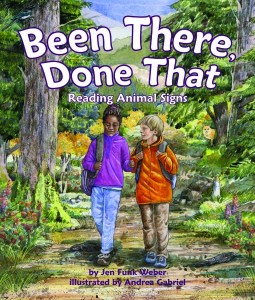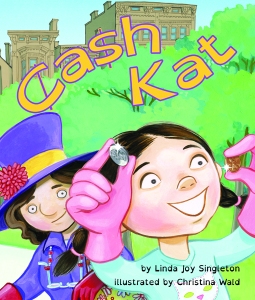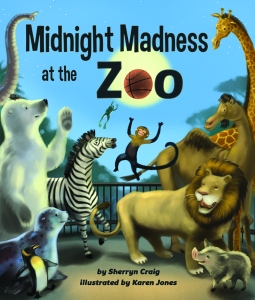
Have you ever walked through the woods and wanted so badly to see animals only to be disappointed that none were around? That is the premise of Jen Funk Weber’s new children’s book Been There, Done That: Reading Animal Signs.
In the book, Cole is visiting his friend Helena and he really wants to see wild animals. They take a hike and Helena shows Cole signs that animals are around even they are not standing in front of him.
This book shows that there is more to spotting signs of wildlife than seeing paw prints across the hood of your car or the imprint of little bird feet in the sand. In fact, tracks are a very little part of spotting signs of wildlife.
Author Jen Funk Weber has a lot of practice tracking animals. Although the animals in Been There, Done That are residents of the Pacific northwest and up through Alaska, Jen has tracked animals around the world. Read this wonderful account of leopard tracking in Africa!
 To celebrate the launch of Jen’s new book we asked her a few questions about writing and tracking animal signs.
To celebrate the launch of Jen’s new book we asked her a few questions about writing and tracking animal signs.
What was your incentive to write this particular book?
Having worked as a natural history guide in Alaska, I know that people want to see exciting things when they take the time and make the e ort to get out in nature, but that’s not the way nature works. Flowers and wild animals don’t perform on command. In fact, most wild animals prefer to avoid humans.
But things are happening all the time in nature, and there are clues all around that can help us “see” what’s happening, even if we don’t actually witness it. It’s fun looking for these clues and trying to figure out what happened. It’s like snooping on neighbors, except the animals don’t seem to mind. If we spend enough time out there, we might get lucky and see some of those really exciting, once-in-a- lifetime events.
 And, of course, hiking, searching for animal signs, and watching wildlife are some of my favorite things to do, but you guessed that, right?
And, of course, hiking, searching for animal signs, and watching wildlife are some of my favorite things to do, but you guessed that, right?
When are you most creative?
Around 4 a.m. No, really. I love getting up in the wee hours to write. Picture this: It’s zero degrees outside, snowy, and dark. But it’s warm enough inside—at least it is at my desk, two feet from the heater. e sky is full of stars and maybe northern lights. It won’t get light for hours. I turn on colored lights that rim the ceiling and light fragrant candles on the windowsills. I make a pot of jasmine tea. I sit. It’s quiet and still. I imagine. I write.
Okay, it’s not always that way, but sometimes it is.
As for what sparks my creativity; that would be new ideas and experiences. It can be something as small as a headline or a fascinating fact, or it can be a trip to someplace new, or it can be thinking about something in a new way, i.e., a new perspective. Every new thought or experience gets processed into past thoughts and experiences, and this synthesis triggers the creative process.
For instance, while converting feet to meters, I wondered why the US has never really converted to the metric system. When I was a kid, we were told we needed to switch because the whole country would soon switch.
 I began to wonder why time has never been converted to the metric system, even where the metric system is used. Instead of 24 hours in a day, we could have 10 or 100 some-other-unit-of- measure.
I began to wonder why time has never been converted to the metric system, even where the metric system is used. Instead of 24 hours in a day, we could have 10 or 100 some-other-unit-of- measure.
Now I’m motivated to do some research about metrics. An old idea—converting to the metric system—leads to creative thinking when applied in a new way—to time.
Read our full interview with Jen on the Been There, Done That homepage!
Also enter to win our Goodreads giveaway that opens on February 15th!


It’s that time of year! Seven new books from Arbordale make their way into the hands of young readers across the country. This week we will be highlighting each book and their creators on our blog.
Before you learn about the inspiration for each of these books get to know the spring line up and pick your must have title for 2016!
 Been There, Done That: Reading Animal Signs
Been There, Done That: Reading Animal Signs
by Jen Funk Weber
illustrated by Andrea Gabriel
Spotting wildlife is a thrill, but it’s not easy. When Cole comes to visit his friend Helena, he can’t wait to see all the wildlife the forest has to offer—and disappointed when all he sees are a few birds. Together the kids set out on a hike and encounter plenty of animal signs along the way. Through observation and her knowledge of animal behavior, Helena helps Cole learn what each of the signs means: something had been there; something had done that.
 Cash Kat
Cash Kat
by Linda Joy Singleton
illustrated by Christina Wald
Gram Hatter and Kat set off on an adventure. Gram quickly folds up a pirate hat and places it on Kat’s head and they begin their mission to help clean up the city park. Volunteering turns into a treasure hunt as Kat finds pennies, nickels, dimes, quarters and even a dollar. With each discovery Kat gets a new hat and Gram Hatter teaches Kat how to count her coins as they pick up litter at the park. When Kat adds up her money, there’s enough for ice cream. Or should she donate the money to support the park instead?
 Mammals
Mammals
by Katharine Hall
All mammals share certain characteristics that set them apart from animal classes. But some mammals live on land and other mammals spend their lives in water—each is adapted to its environment. Land mammals breathe oxygen through nostrils but some marine mammals breathe through blowholes. Compare and contrast mammals that live on land to those that live in the water.
 Midnight Madness at the Zoo
Midnight Madness at the Zoo
by Sherryn Craig
illustrated by Karen Jones
The bustle of the crowd is waning and the zoo is quieting for the night. The polar bear picks up the ball and dribbles onto the court; the nightly game begins. A frog jumps up to play one-on-one and then a penguin waddles in to join the team. Count along as the game grows with the addition of each new animal and the field of players builds to ten. Three zebras serve as referees and keep the clock, because this game must be over before the zookeeper makes her rounds.
 Once Upon an Elephant
Once Upon an Elephant
by Linda Stanek
illustrated by Shennen Bersani
From stopping wildfires to planting seeds, one animal is the true superhero that keeps the African savanna in balance. Elephants dig to find salt for animals to lick, their deep footprints collect water for everyone to drink, and they eat young trees to keep the forest from overtaking the grasslands. In every season, the elephants are there to protect the savanna and its residents – but what would happen if the elephants were only “once upon a time”? Read along to discover the important role this keystone species plays in the savanna and explore what would happen if the elephants vanished.
 Sharks and Dolphins
Sharks and Dolphins
by Kevin Kurtz
Sharks and dolphins both have torpedo-shaped bodies with fins on their backs. They slice through the water to grab their prey with sharp teeth. But despite their similarities, sharks and dolphins belong to different animal classes: one is a fish and gets oxygen from the water and the other is a mammal and gets oxygen from the air. Marine educator Kevin Kurtz guides early readers to compare and contrast these ocean predators through stunning photographs and simple, nonfiction text.
 Tornado Tamer
Tornado Tamer
by Terri Fields
illustrated by Laura Jacques
In this adaptation of The Emperor’s New Clothes, Mayor Peacock declares he will hire a tornado tamer to protect the town. After a long search, Travis arrives to fill the position and this weasel has a plan. He will build a very special, transparent cover to protect the town. Travis’ magical cover is so transparent that only those smart enough and special enough can even see it. Mouse is doubtful, but his questions are brushed off. Months later, the cover has been hung and Travis has been paid a hefty sum, but a tornado is in the distance and the town is in its path. Will the magic cover protect the town?
Find out more about our newest titles at Arbordalepublishing.com!



 To celebrate the launch of Jen’s new book we asked her a few questions about writing and tracking animal signs.
To celebrate the launch of Jen’s new book we asked her a few questions about writing and tracking animal signs. And, of course, hiking, searching for animal signs, and watching wildlife are some of my favorite things to do, but you guessed that, right?
And, of course, hiking, searching for animal signs, and watching wildlife are some of my favorite things to do, but you guessed that, right? I began to wonder why time has never been converted to the metric system, even where the metric system is used. Instead of 24 hours in a day, we could have 10 or 100 some-other-unit-of- measure.
I began to wonder why time has never been converted to the metric system, even where the metric system is used. Instead of 24 hours in a day, we could have 10 or 100 some-other-unit-of- measure.



 Been There, Done That: Reading Animal Signs
Been There, Done That: Reading Animal Signs Cash Kat
Cash Kat Mammals
Mammals Midnight Madness at the Zoo
Midnight Madness at the Zoo Once Upon an Elephant
Once Upon an Elephant Sharks and Dolphins
Sharks and Dolphins Tornado Tamer
Tornado Tamer